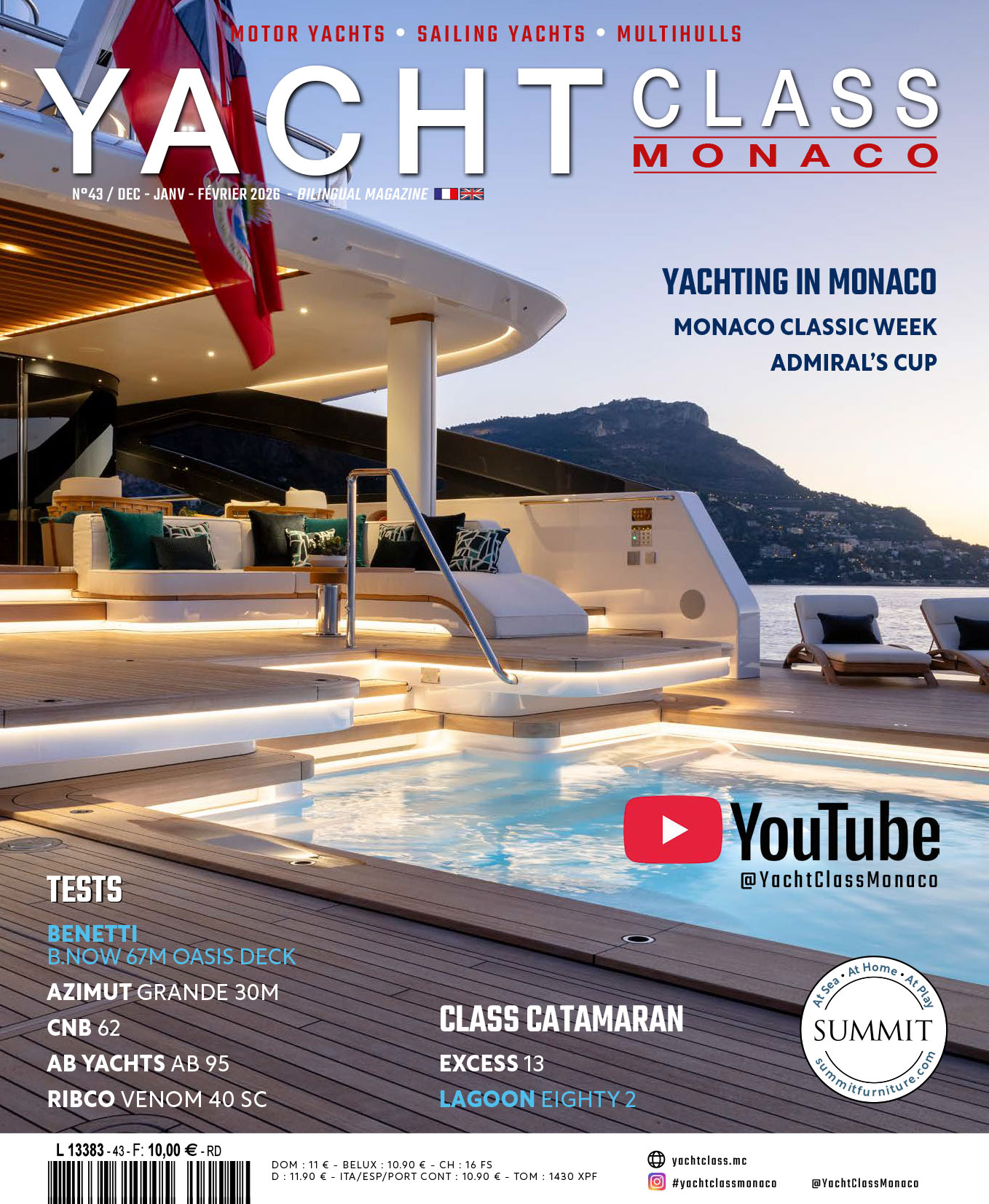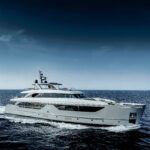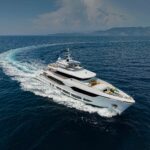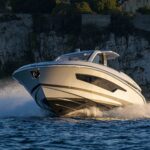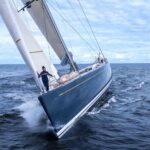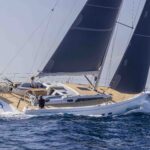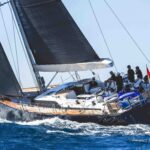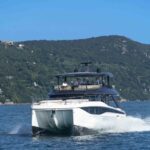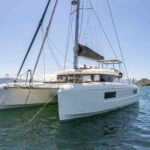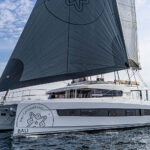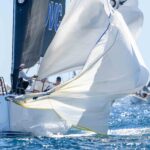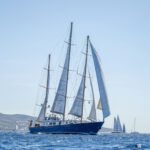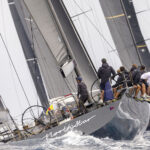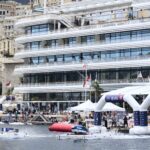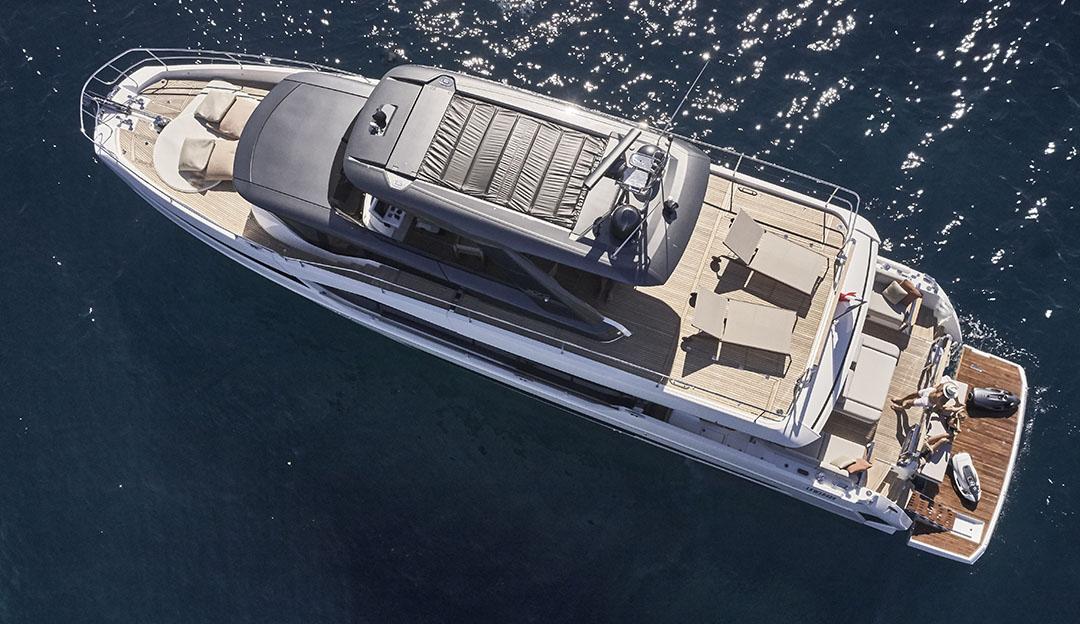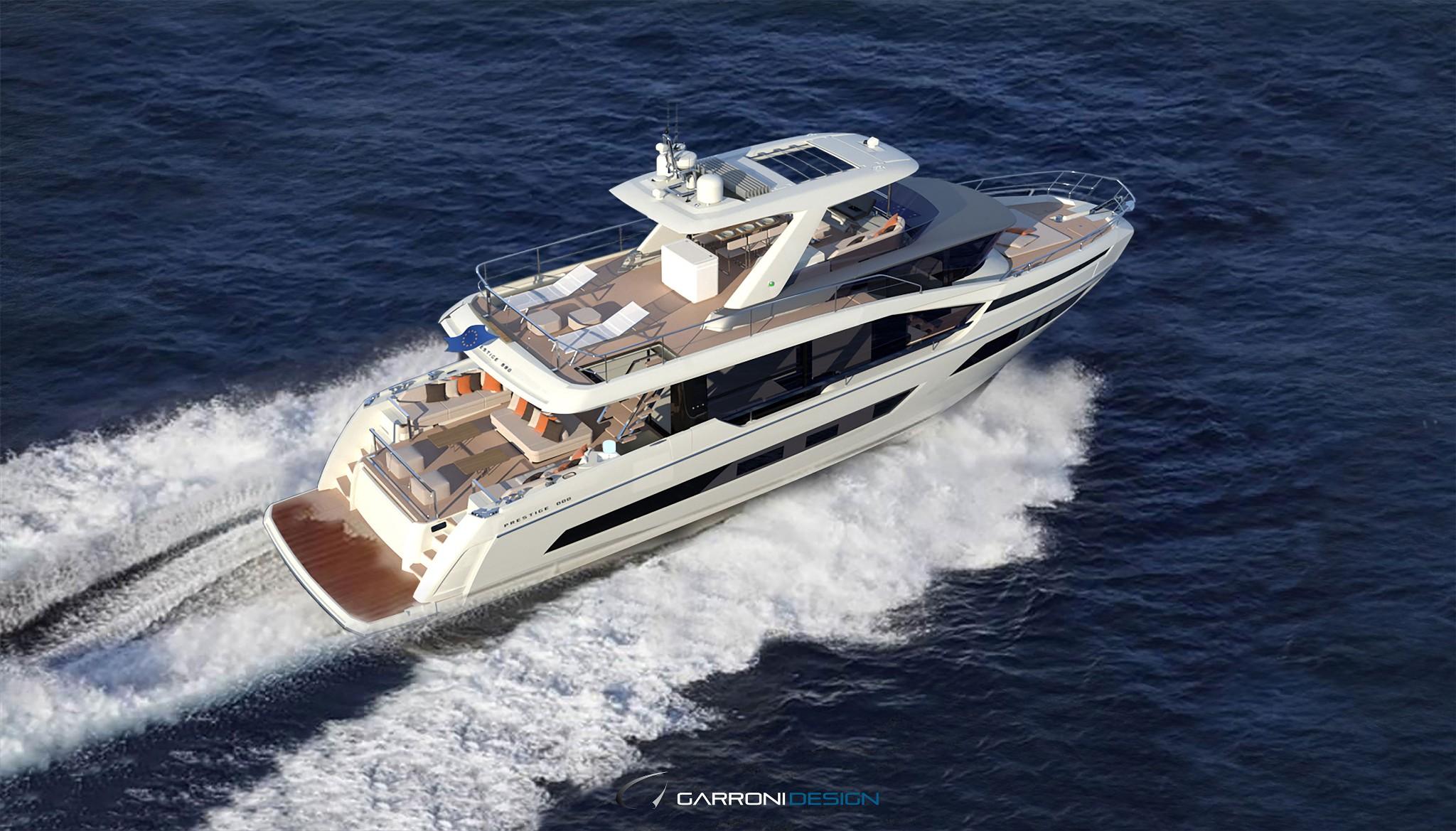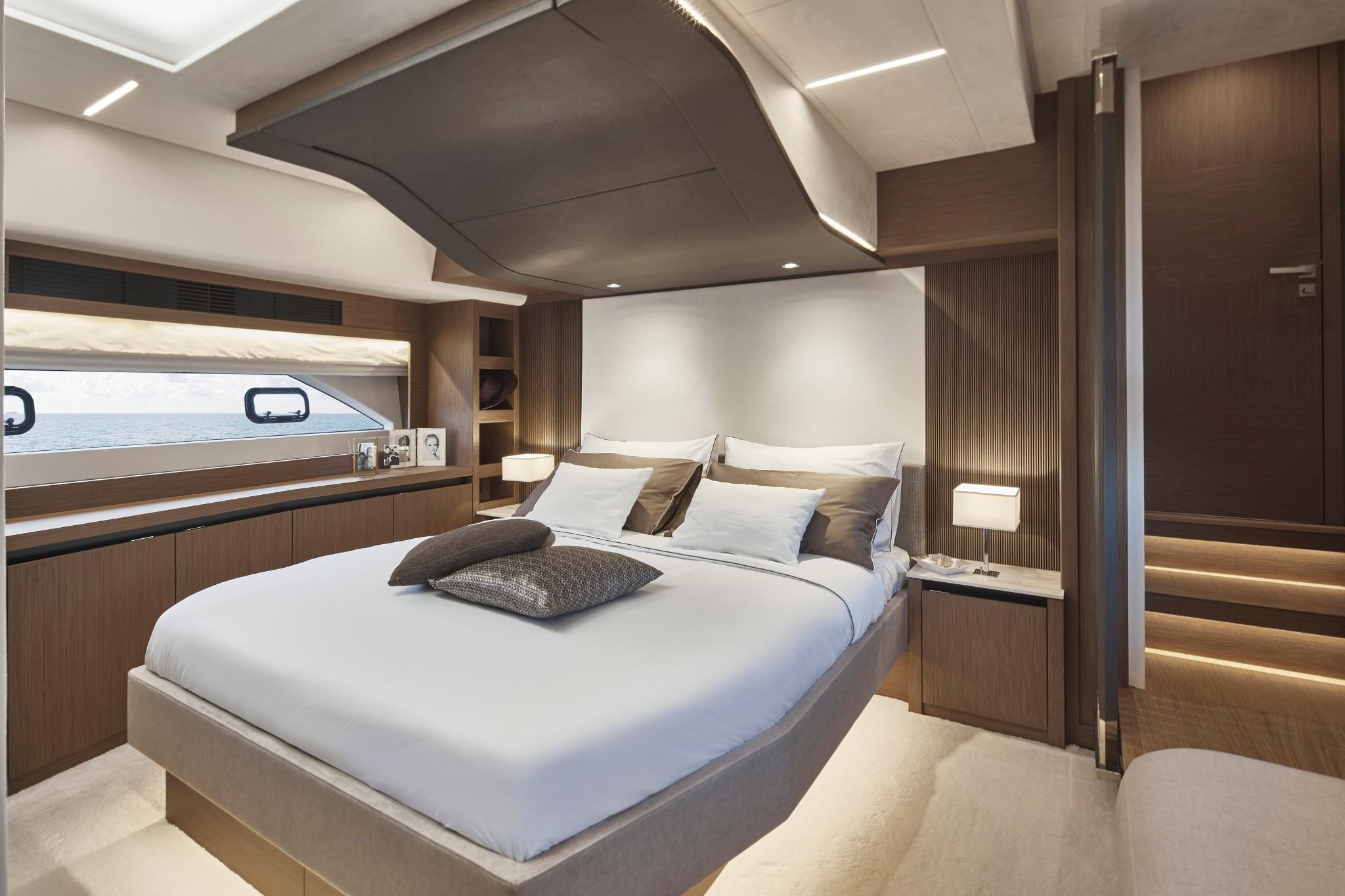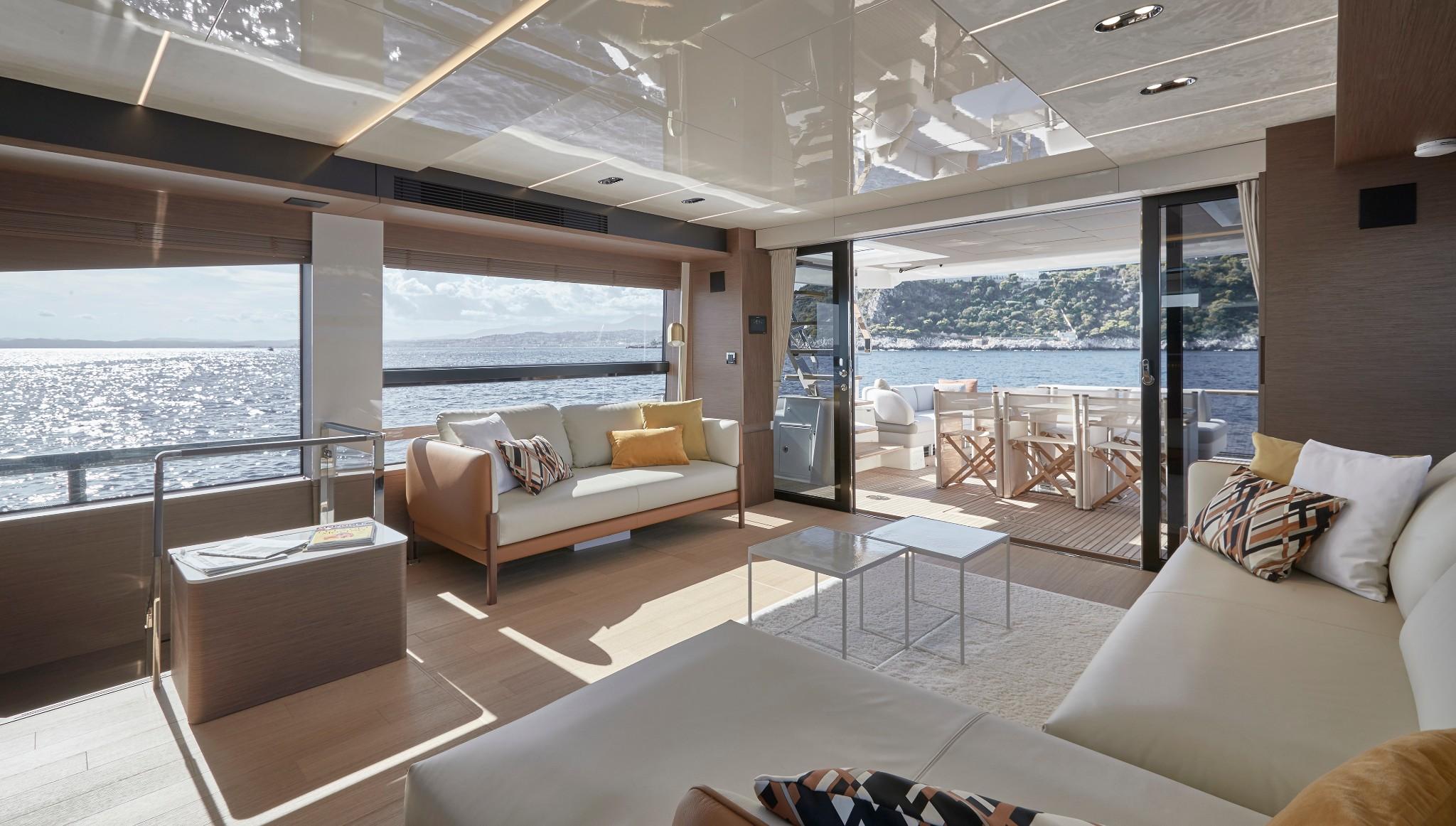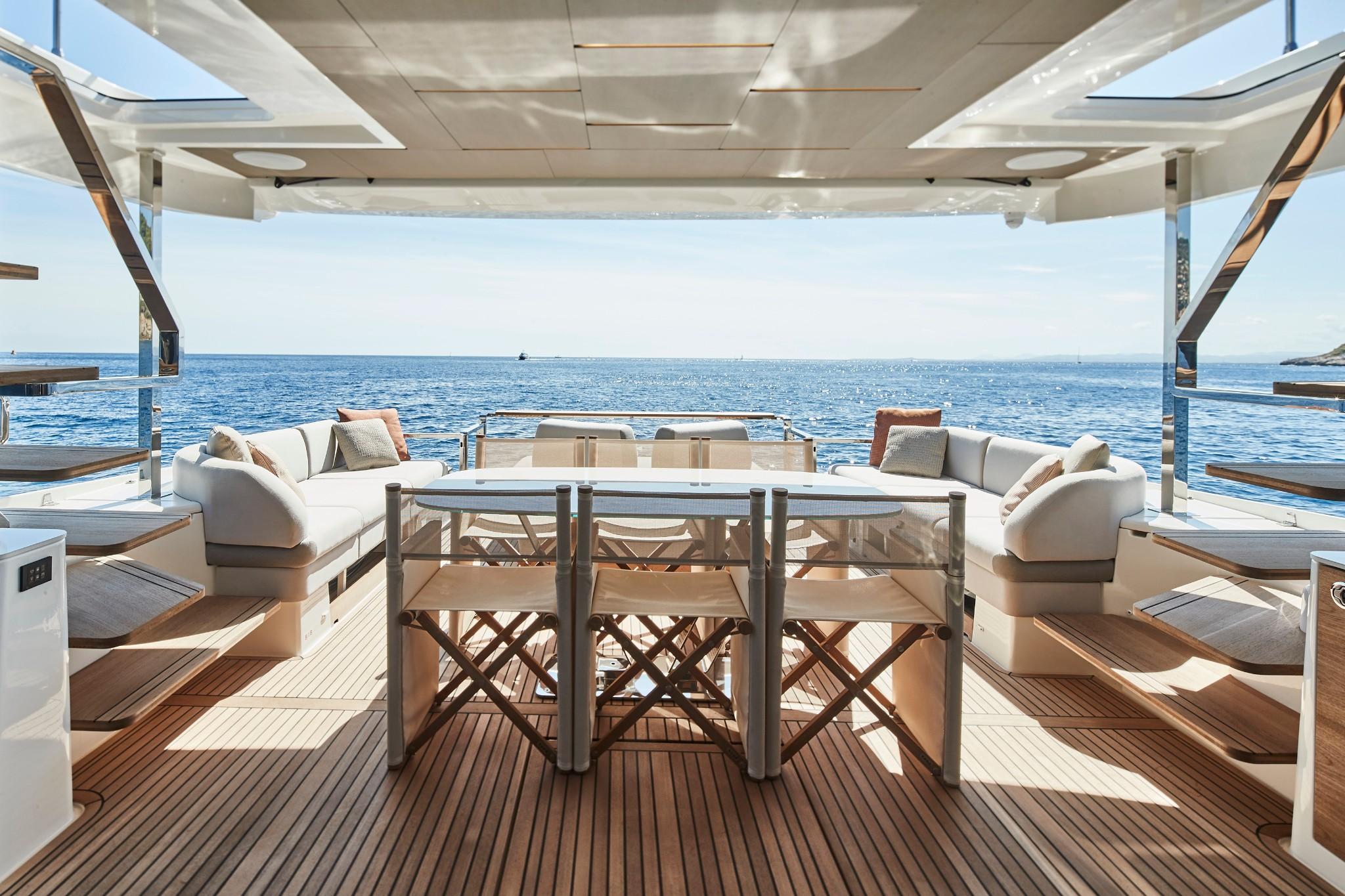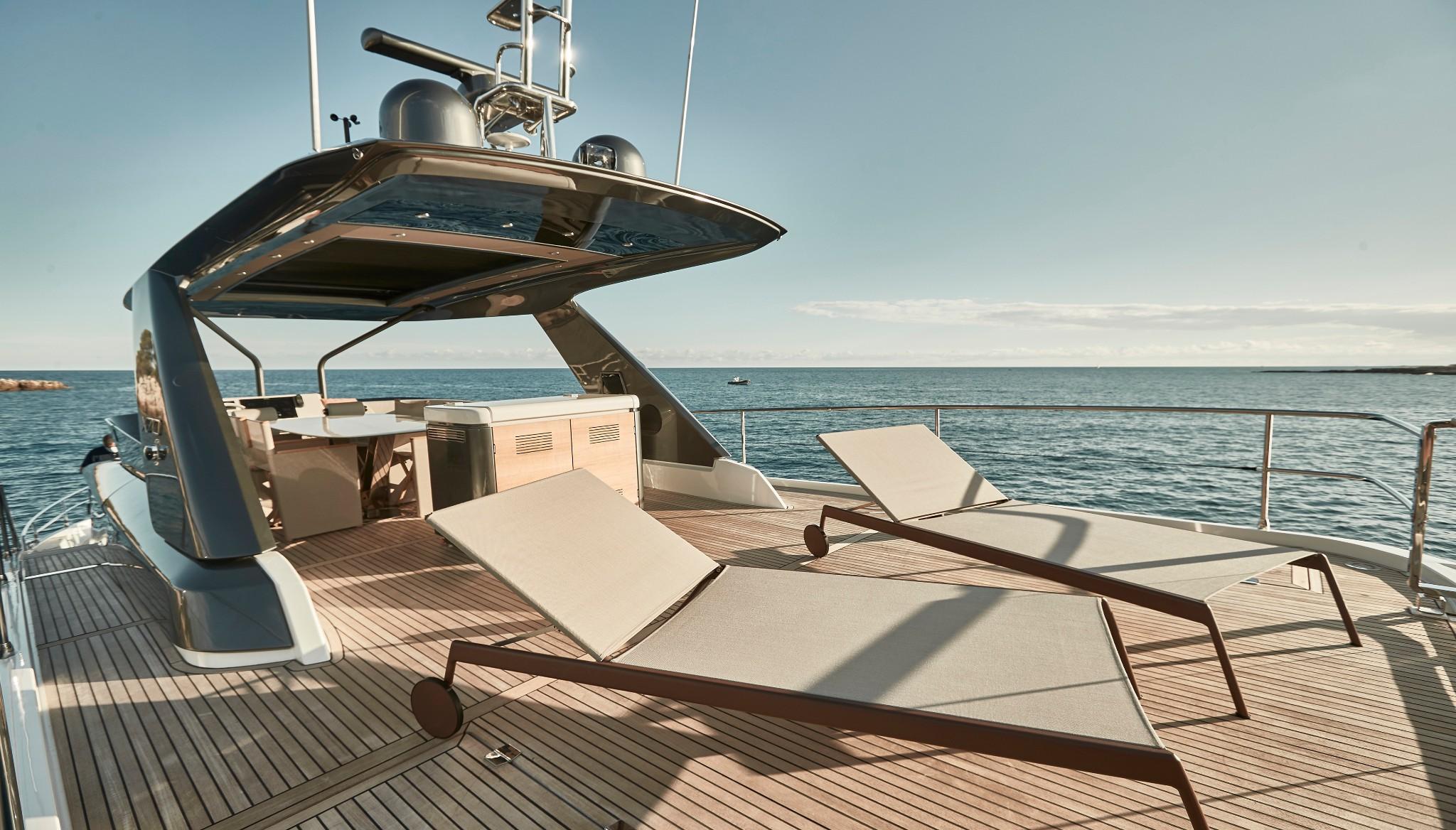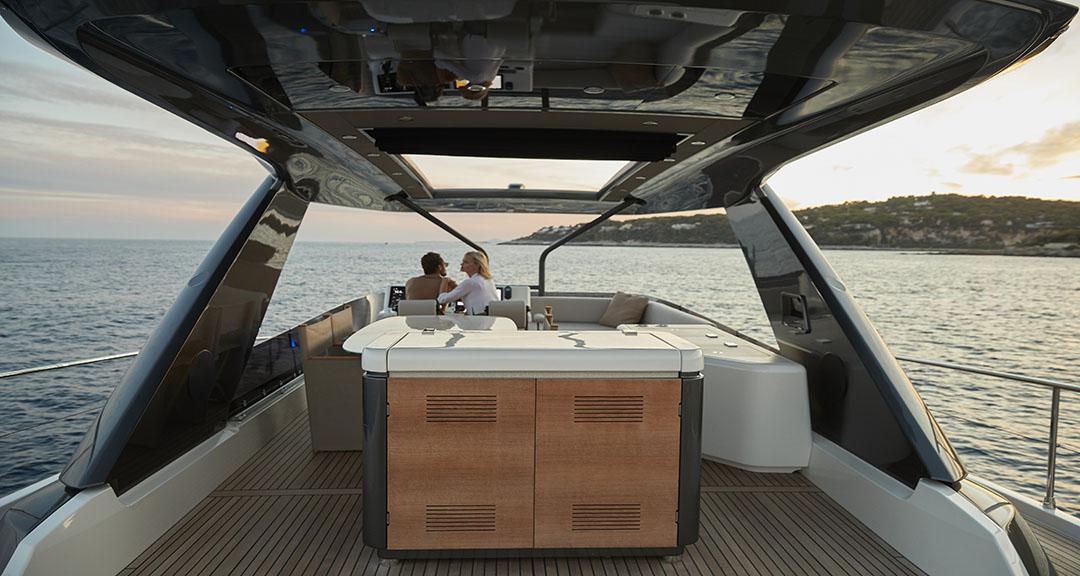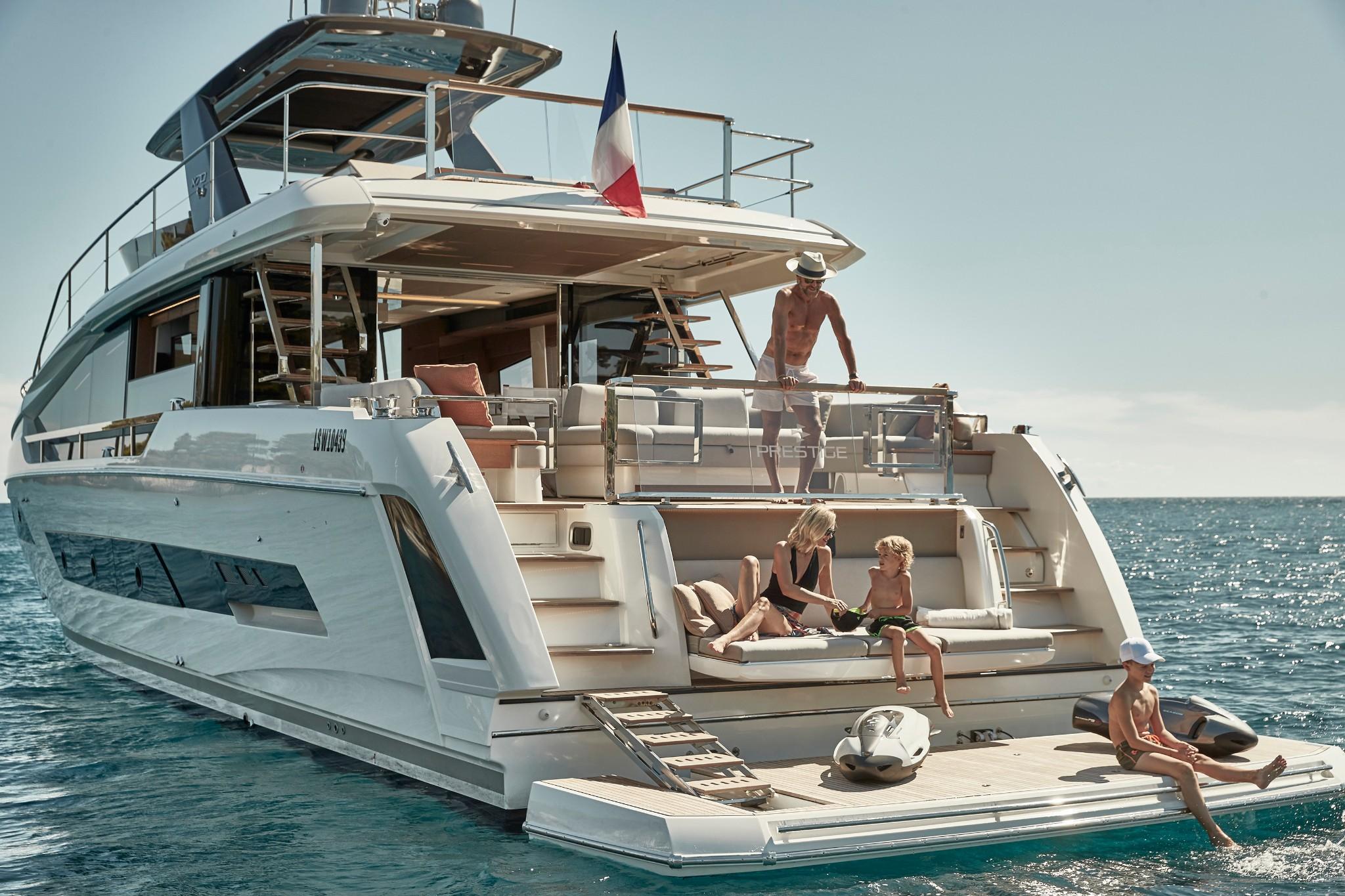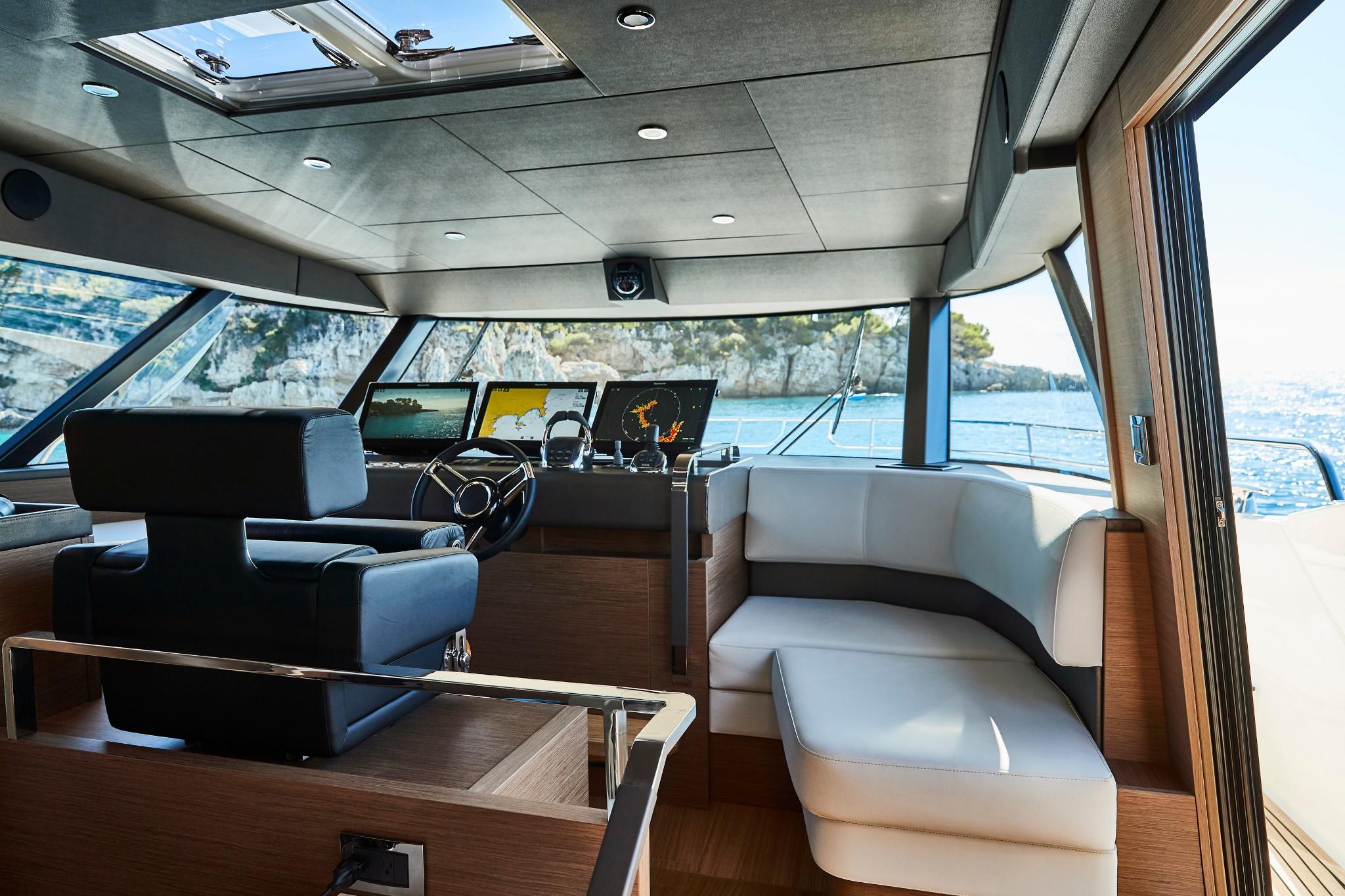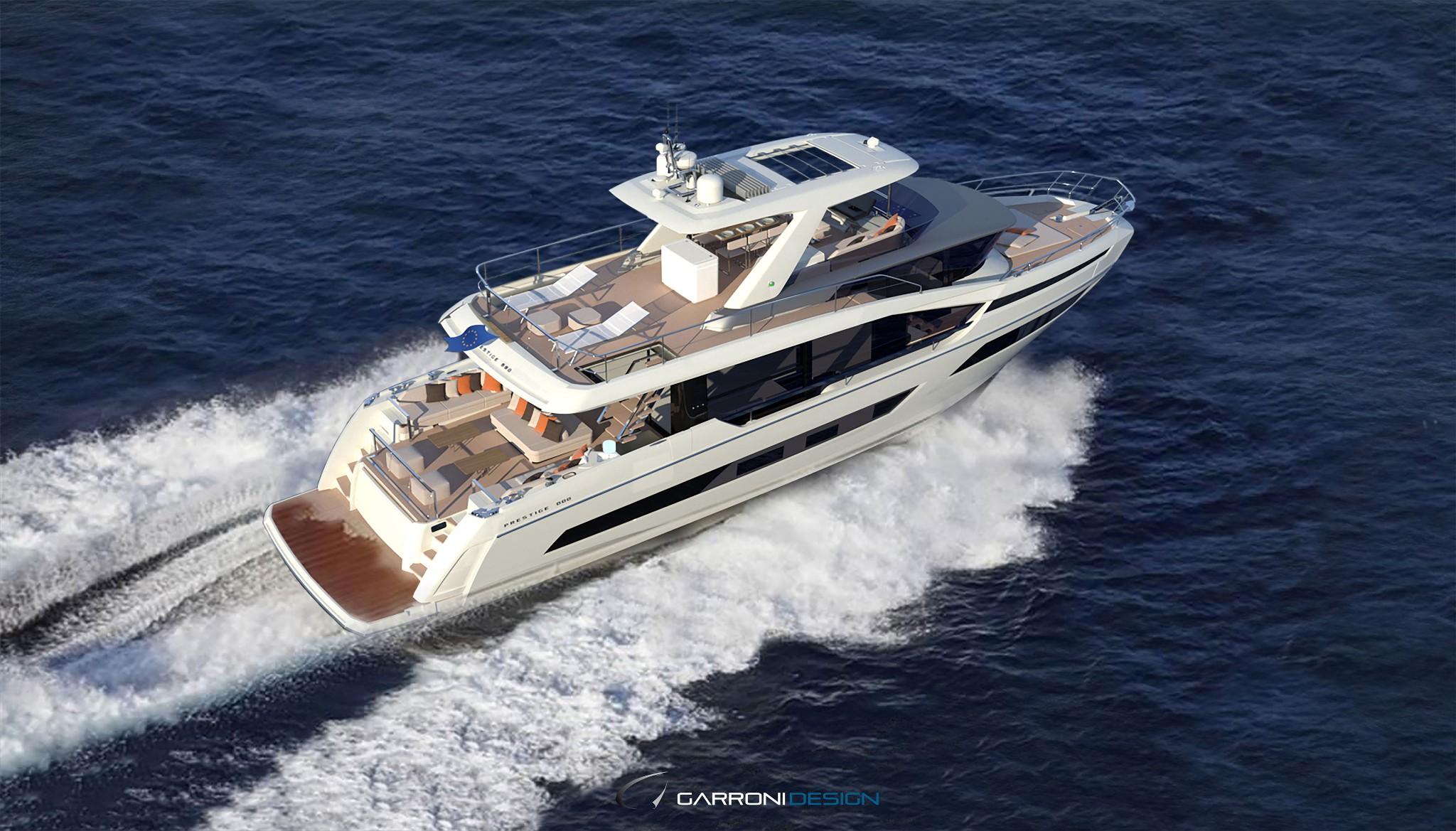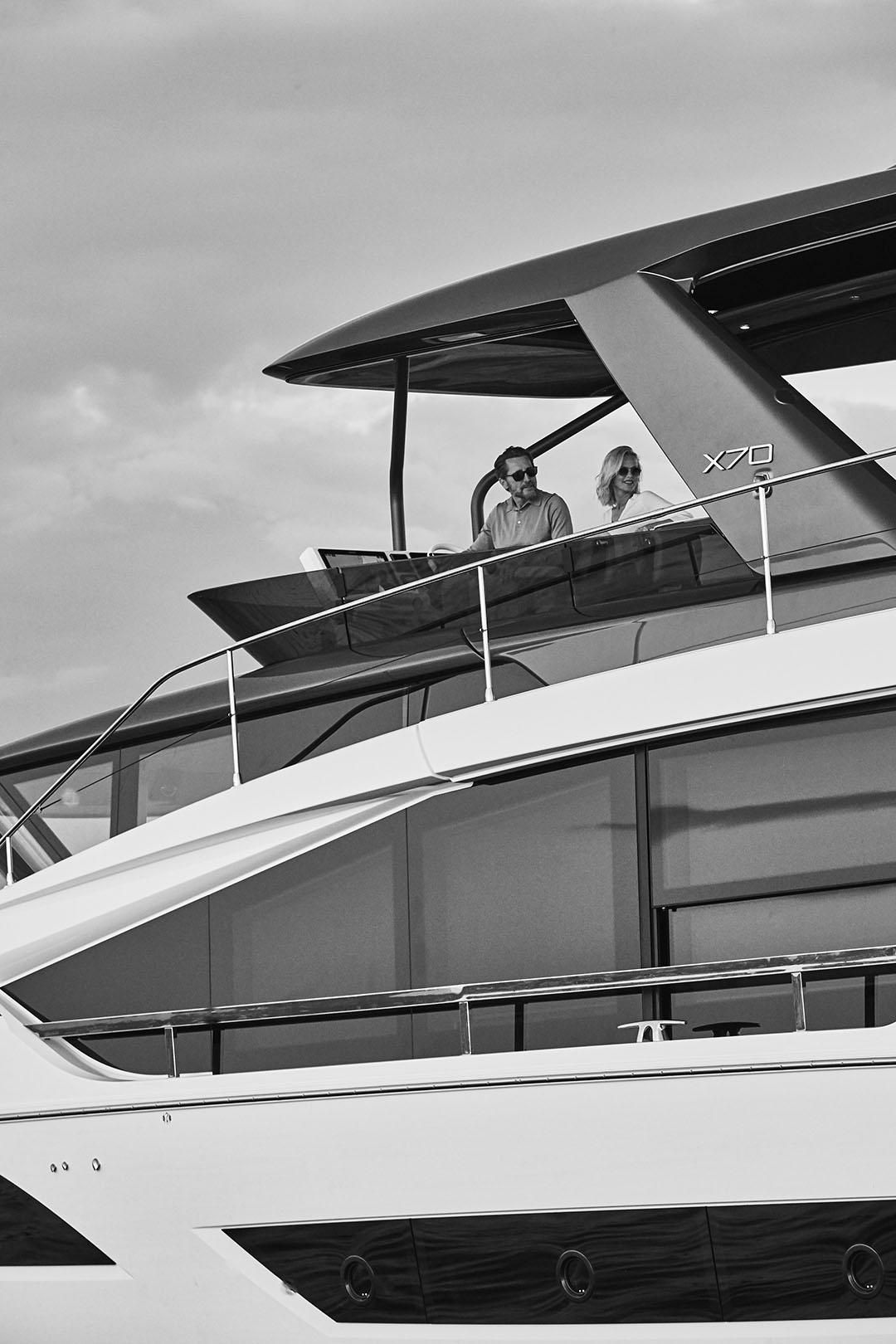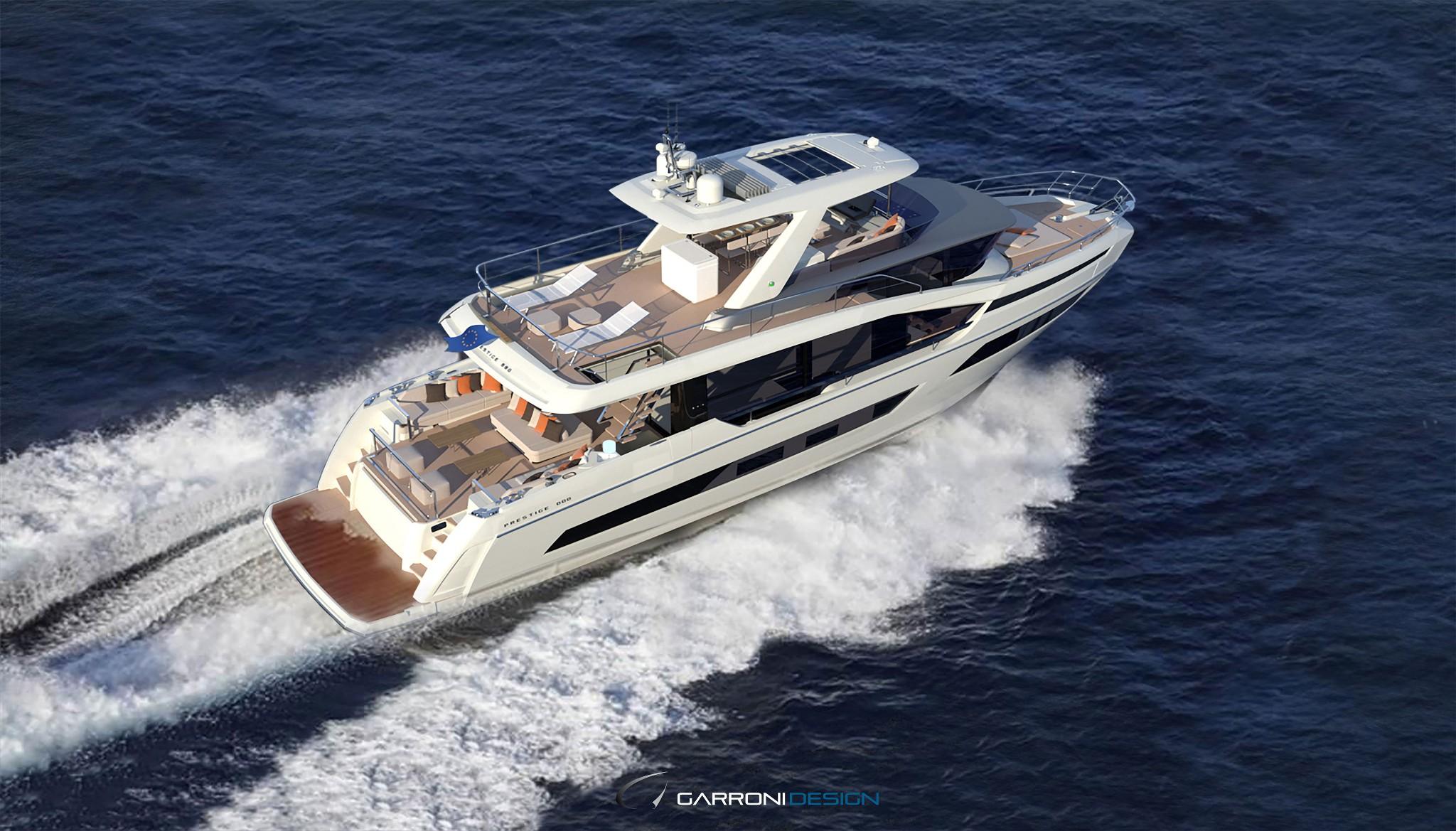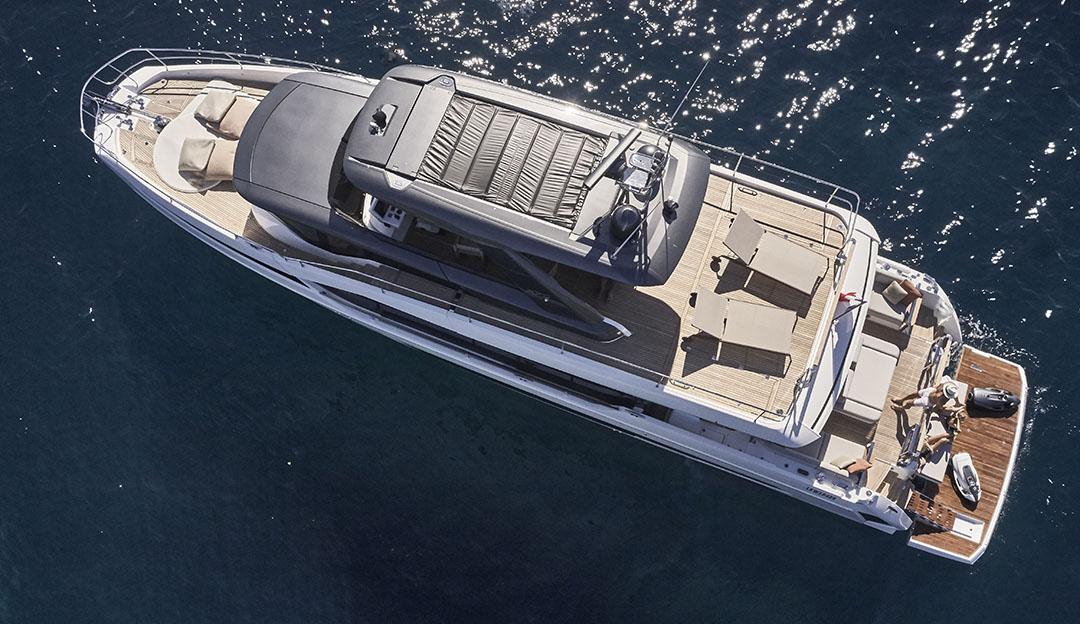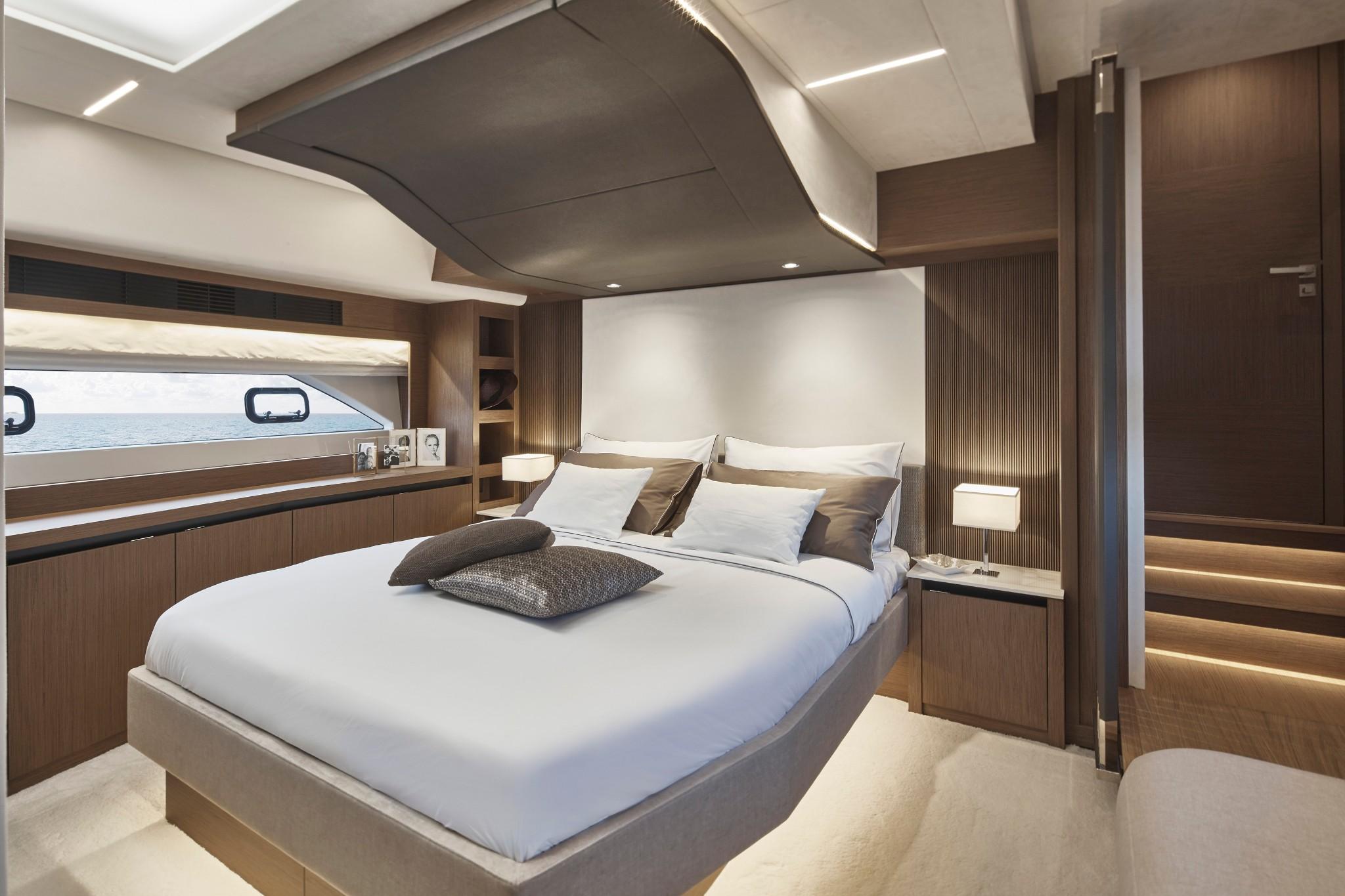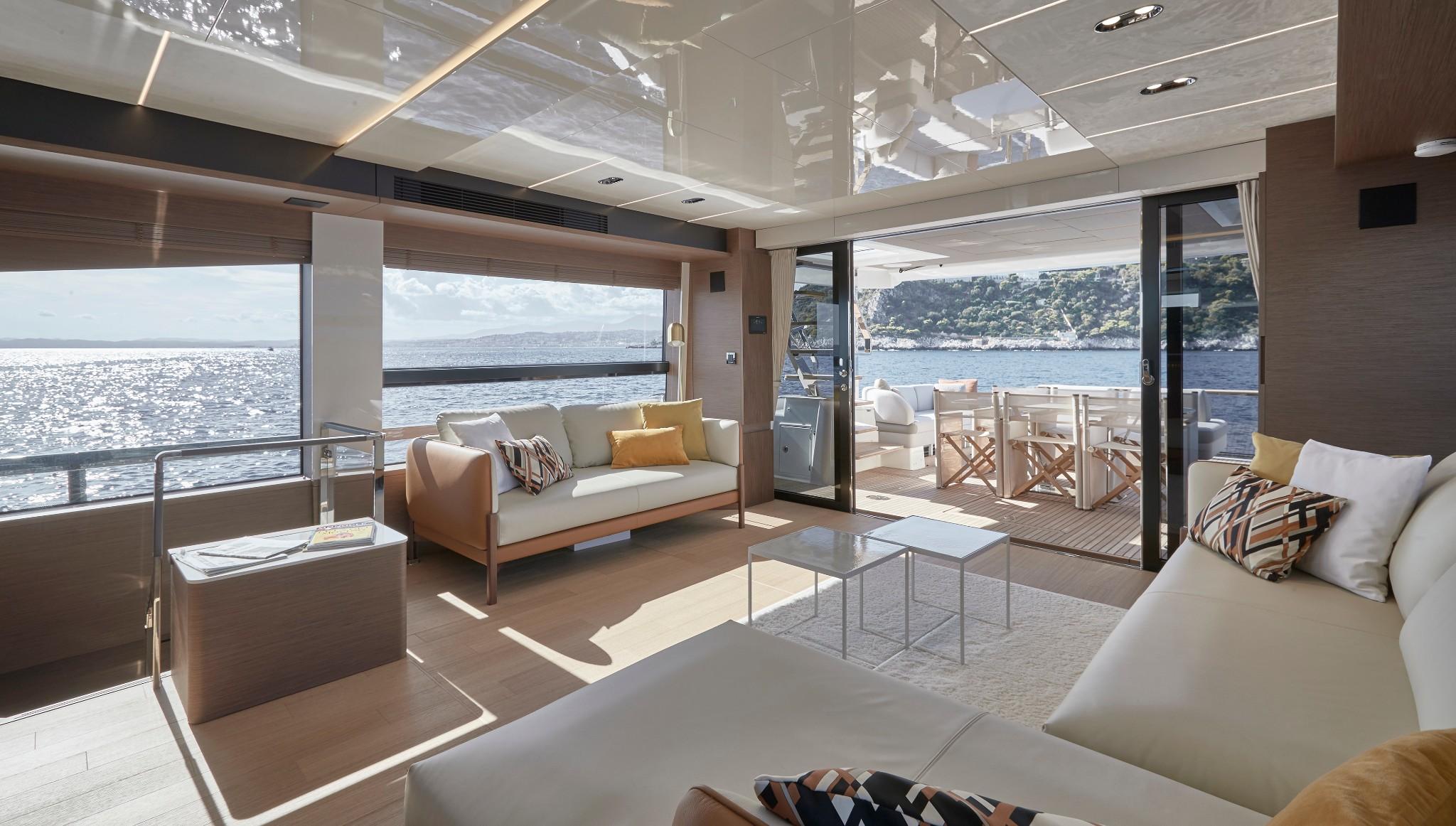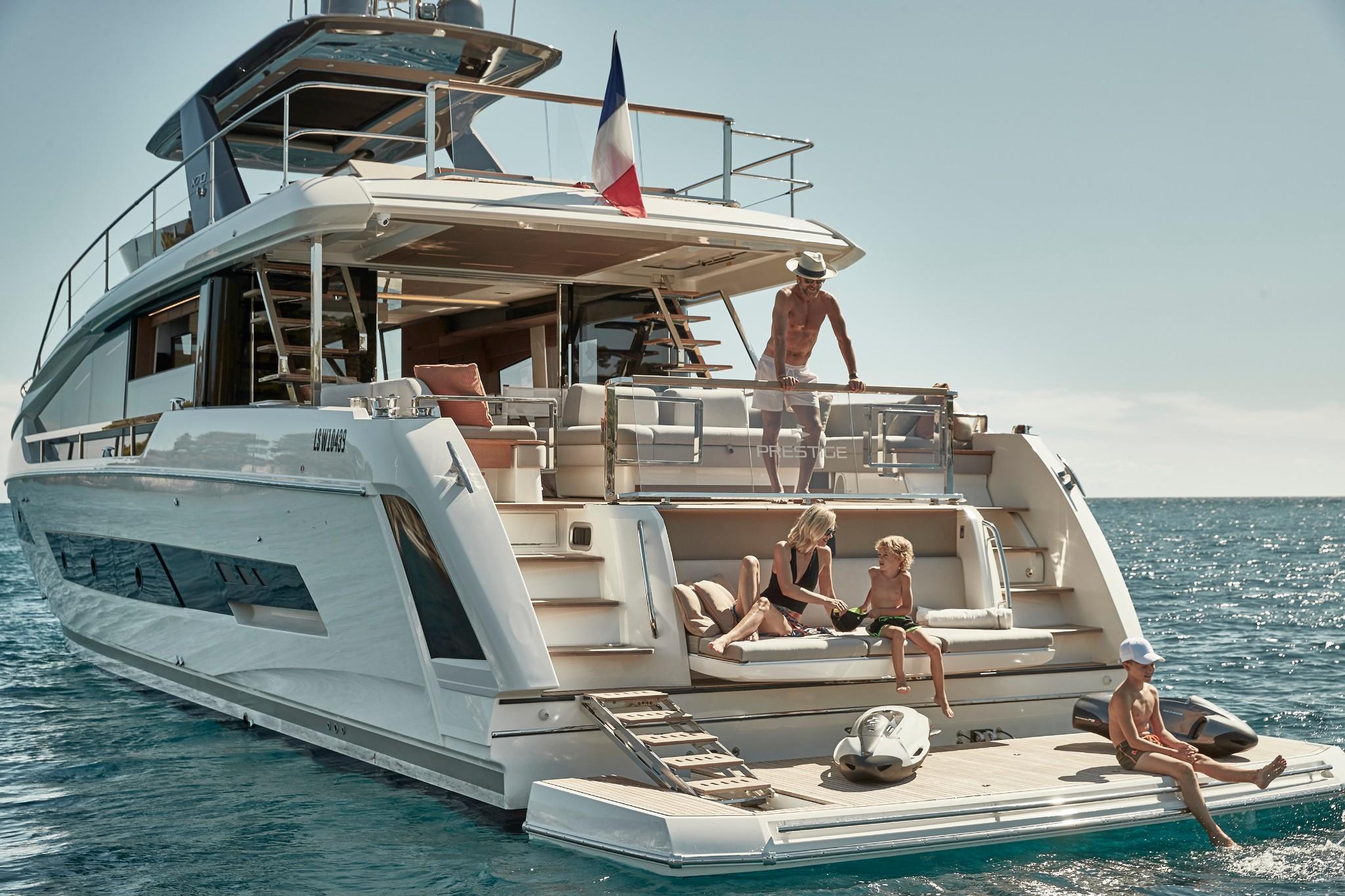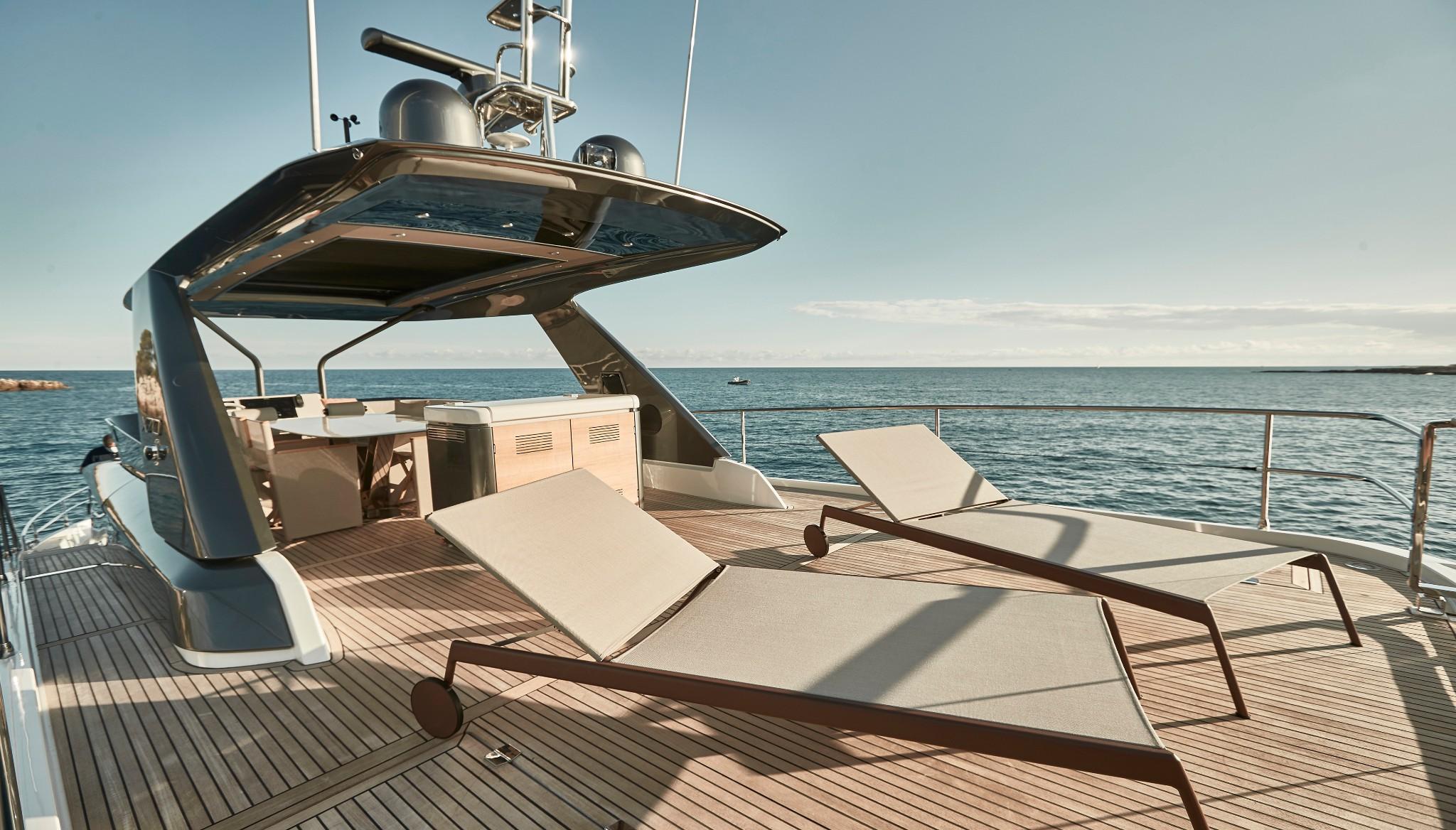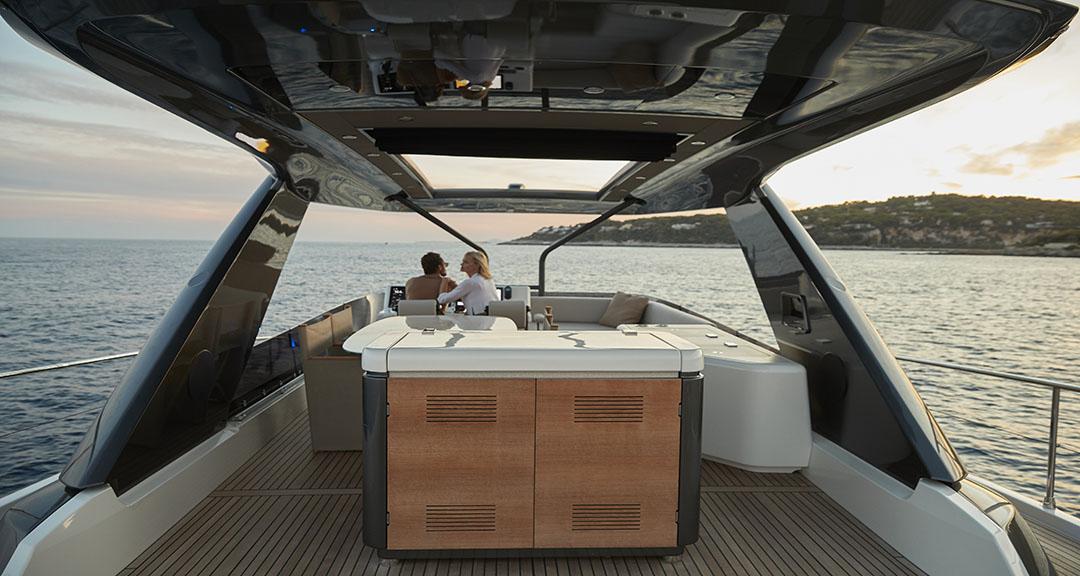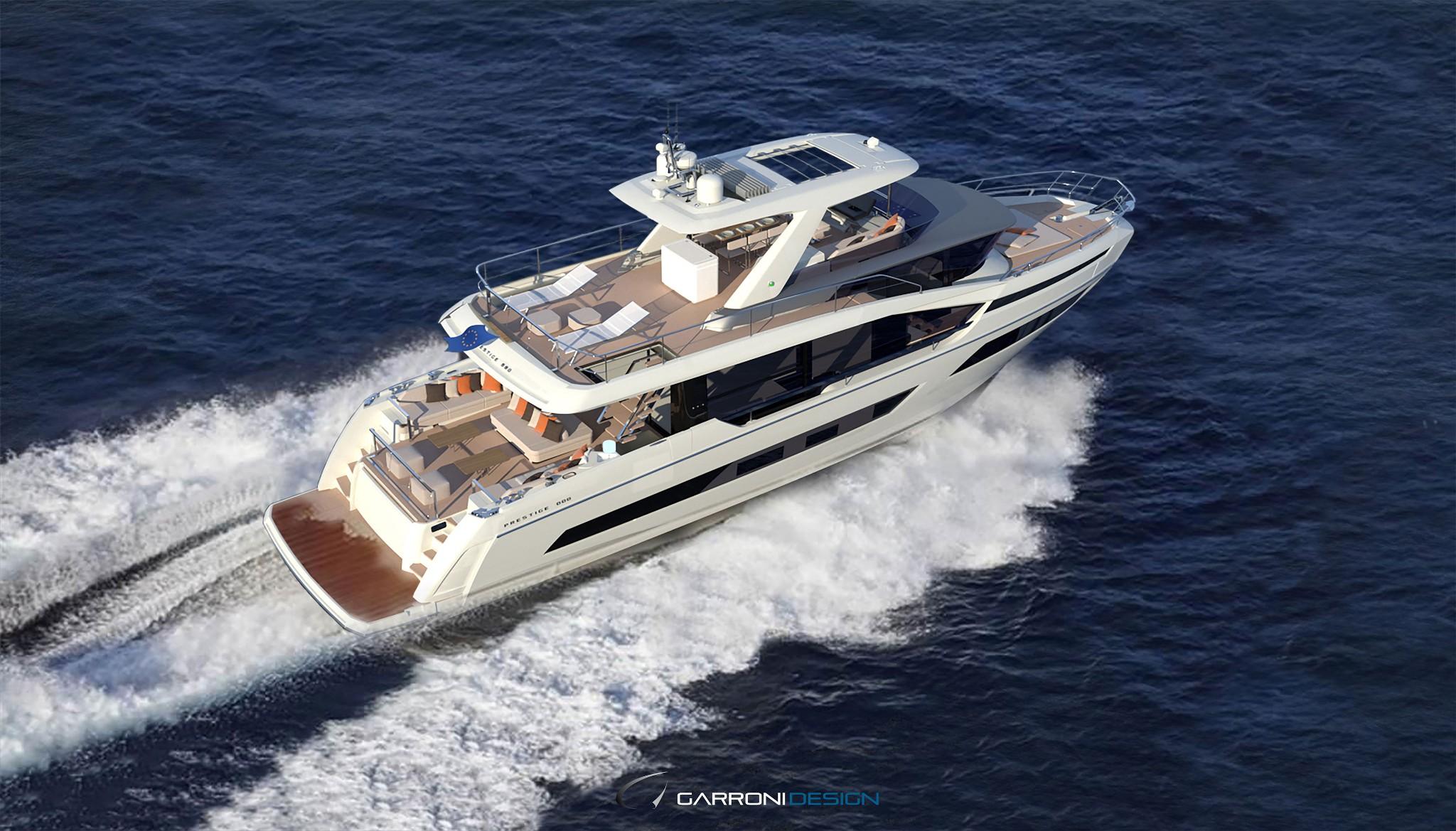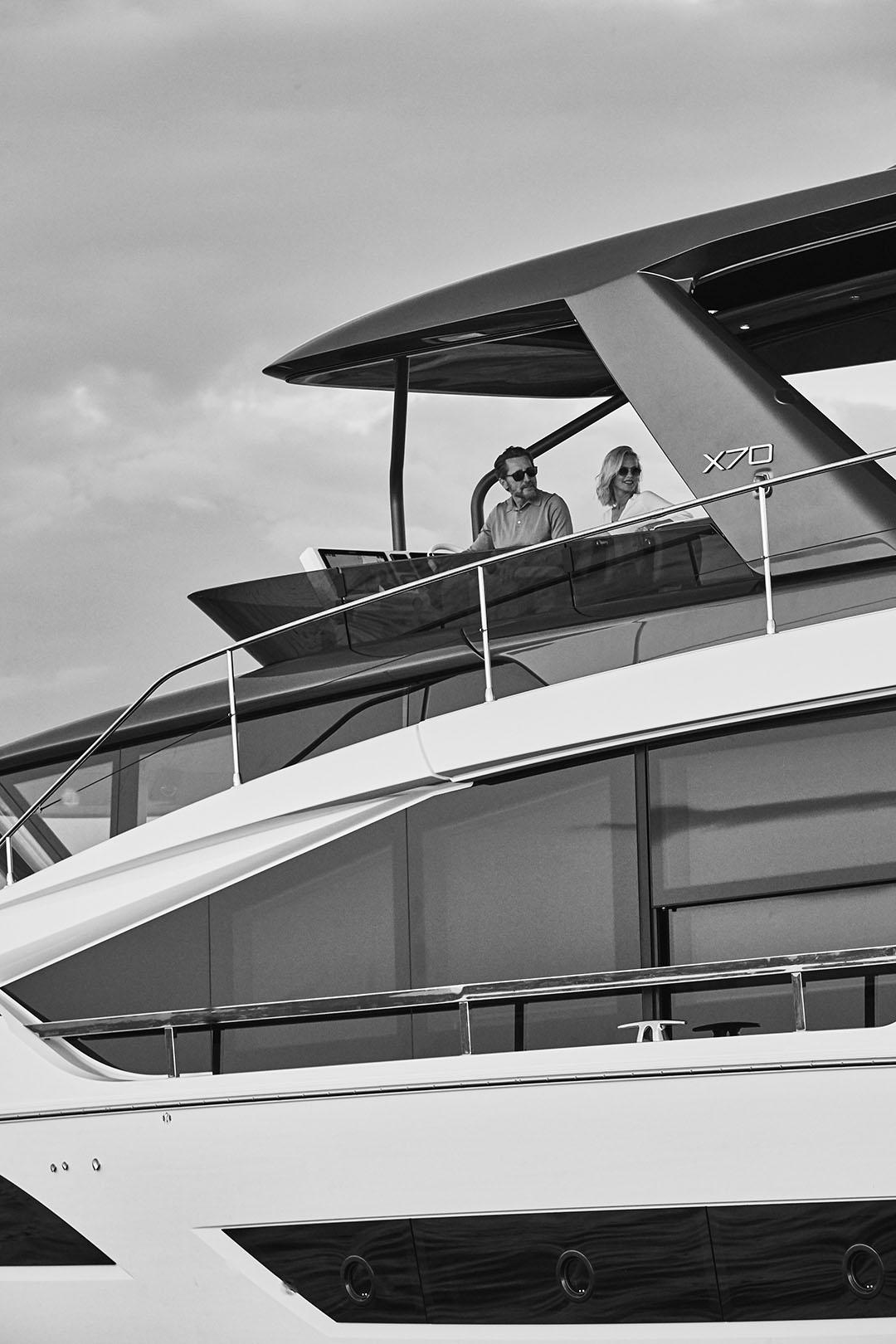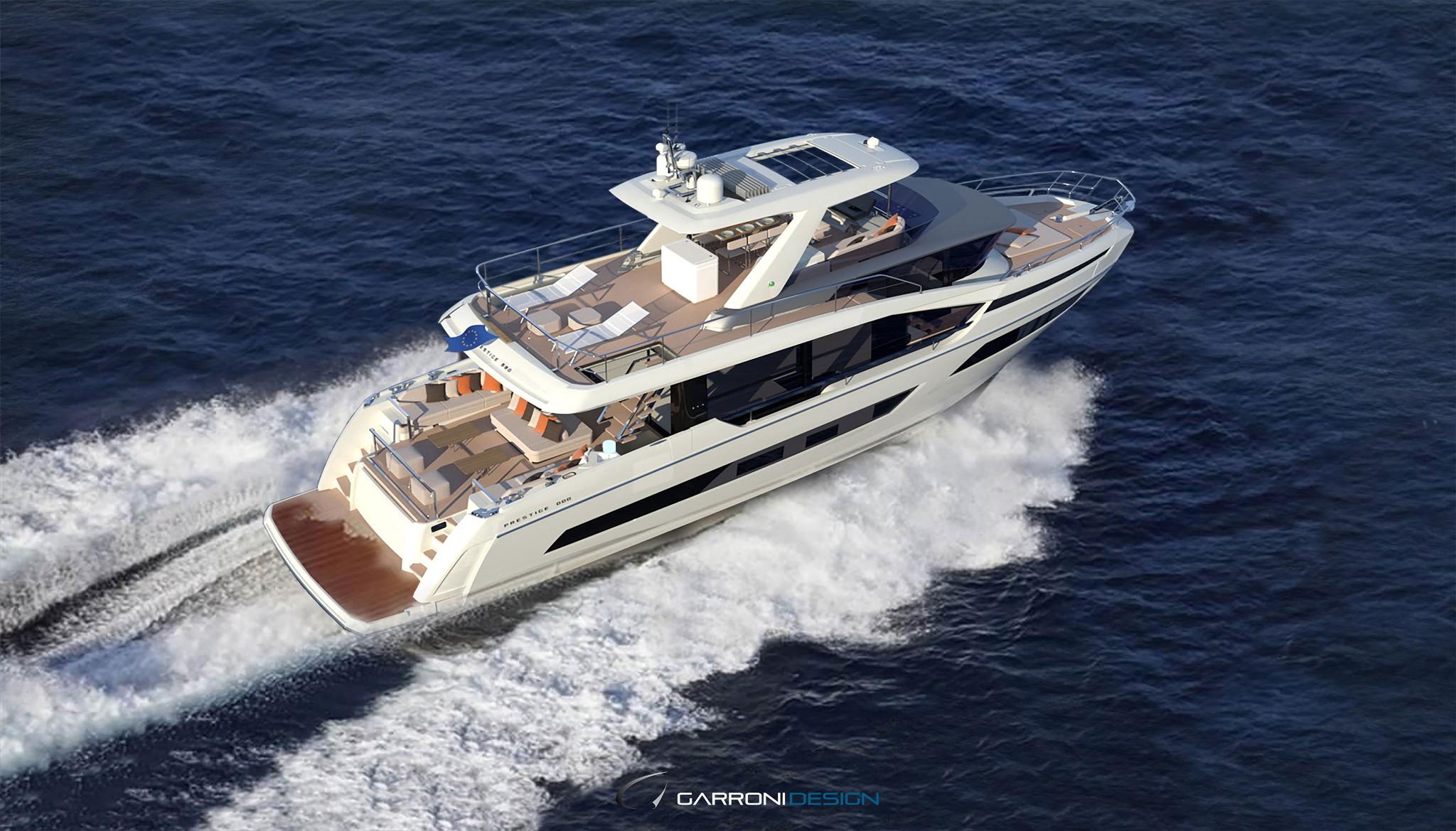Presentation
Yacht Class n°23 (dec 2020/jan-feb 2021)
Prestige Yachts – Groupe Beneteau
Born in Vendée, the Prestige X70 finally sailed her first miles in the Mediterranean with the firm hope that she will draw the attention of yachtsmen sensitive to innovations. A successful mission thanks in particular to its concept of a main deck with no gangways. Full focus on Prestige’s new flagship we owe, among others, to Garroni Design.
Written by Alain Brousse – Photos: All rights reserved
In terms of motoryachts over 15 metres, Italy remains a reference, if not the leader, at least in Europe. It is therefore not surprising that Beneteau Group has developed a solid collaboration with the Genoa-based architecture and design studio Garroni, for its Prestige family. Until last year, it counted fourteen models from 42 to 69 feet divided into three categories : F-Line, S-Line and Sportfly. 2020 is marking a turning point with the arrival of the X-Line and its first unit, the X70. Garroni has somehow invented the Navetta genre with dynamic lines and massive superstructures concealing an advantageous habitability. This three deck plays on her uniqueness, and by looking at her profile, we understood that the yard chose to overlook the main deck gangways. And we immediately looked for the “way” to reach the foredeck. The answer is on the flybridge where side decks lead down to the bow. Just think about it. An exercise in style ? Not really, because the primary purpose is to offer more interior space on the main deck. And we’ll see that the extra 10 m2 bring a real “plus”.
Side decks on the flybridge !
Before discovering the asset of this design, let’s climb aboard the biggest Prestige (not for much longer, as there is a growing rumor of an 80). Let’s start with the stern with its swim platform and its transom that can be lowered electrically to form a settee for four. There, there is an opening in the starboard staircase leading to a small crew cabin with an independent shower and toilet area next to a double bed. Entering this place requires some precautions because of the narrow vertical ladder. The shipyard is aware of this and should replace it. The platform also has two staircases leading to the cockpit and the first positive finding : the glazed aft pulpit does not conceal the spectacle. Another source of satisfaction : from the stern to the bow, the outdoor are covered in teak, which is certainly higher maintenance than polyester, but so much more pleasant to look at and walk on. Given the cockpit size (18 m2), two layouts are possible : the dining table (six guests) can be either fitted there or in the saloon (28 m2). In both cases, the sea view is ensured. Let’s stay in the cockpit where, in addition to the dining area, there is a solarium “cabinet” that also serves as a settee. And since the side decks are on the flybridge, the designer has fitted out a sofa on each side of the cockpit, making it very comfortable. Still in the cockpit, two staircases climb up to the flybridge, but the owner can also opt for only one of them to gain some space and fit a barbecue instead. The 40 m2 upper deck, partly protected by a sunroof (“accordion” canvas system), is particularly convivial. Following tradition, the aft deck can accommodate either sun loungers or an outdoor lounge, and then comes the very popular dining area (a table and six chairs) with an opposite barbecue, contiguous to an L-shaped sofa extending to the helm station. The latter features a very complete dashboard including two 19-inch screens and two ergonomic armchairs protected by a windshield, welcome regardless of Aeolus’ mood. As promised, both sides of the flybridge feature a teak-covered gangway, leading down, via a few steps, to the foredeck. There, there is no equipment, such as a settee and coffee table, but only cushions, which are very pleasant when lying down. The technical area is at the end of the deck.
Three or four cabins ?
On the day of our sea trial, the Prestige featured a cockpit with a dining area configuration, so the 28 m2 saloon seemed particularly spacious. Even too much, maybe, as we couldn’t help but immediately imagine six guests seated around a table, enjoying the meals prepared in the discreet open-plan galley nearby… The American customers should appreciate this configuration, and they will probably not be the only ones… Thus by eliminating the gangways on the main deck, Garroni Design has given this X70 an unexpectedly spacious lounge for a 20 metre. To discover the sleeping area, let’s head belowdecks. First of all, as always on Prestige, the master cabin has a private access located in the saloon on starboard. With its headroom of over two metres, its 22 m2, its natural lighting coming directly from the portholes and its king-size bed, its comfort should please the master couple. As for the guests, the Prestige can either accomodate three other cabins, one VIP and two twins, when there are many of them or two VIP when there are only two couples. In this case, each cabin has its own bathroom.
Two Volvo IPS engine configurations
The slightly elevated wheelhouse is located in the main deck. Open on two-thirds, it allows the captain to see the stern, unless he uses the video surveillance. Above the electric controls and the joystick are three touchscreen displays controlling everything, including the engines and peripheral devices. The hull was designed to be powered by the most powerful Volvo Penta IPS diesel engines : the 1 350 ones, each developing 1 000 hp. Very discreet at idling speed, they then delivered a correct sound level : 66 dbA at 20 knots in the saloon, and a little more in the master, forward of the lower deck : 69 dbA. A remark : at low speed, the skipper doesn’t have much choice but to sit on the chair, if not his visual range will be reduced towards the top of the windshield. We discovered the horizon by putting some acceleration and the Prestige went from 0 to 20 knots in eleven seconds, a good result for a 20 metre of more than 30 tons in load. This exercise allowed us to note that the hull gets in its hydroplaning position without the so-called “stair step” effect. We only had the wake of a 30-metre to realize that the hull goes smoothly over this wave. In curves, she also remains serene. We would have so much appreciated a rough sea but, unfortunately, the calm reigned on the day of our trial… Note that Prestige offers a X70 with a more reasonable configuration : two Volvo Penta IPS1200 diesels (2 x 925 hp).
With this X70, Prestige is taking a new step and does not intend to stop there. That’s at least our intuition. In other words, the yard admits that logically a larger model could be under consideration. An 80 foot for example. Let’s hope to see it in a not too far future time.
Technical sheet
